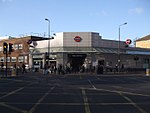Belgrave Hospital for Children
1990 disestablishments in EnglandArts and Crafts architecture in EnglandCharles Holden buildingsChildren's hospitals in the United KingdomDefunct hospitals in London ... and 6 more
Grade II* listed buildings in the London Borough of LambethHealth in the London Borough of LambethHistory of the London Borough of LambethHospital buildings completed in 1926Hospitals established in 1866Voluntary hospitals

The Belgrave Hospital for Children in Kennington, London, United Kingdom was a voluntary hospital founded in Pimlico, London in 1866. A new hospital building was constructed between 1899 and 1926 at 1 Clapham Road from a design by Charles Holden. It was designated a Grade II* listed building in 1981 and is currently residential flats.
Excerpt from the Wikipedia article Belgrave Hospital for Children (License: CC BY-SA 3.0, Authors, Images).Belgrave Hospital for Children
Clapham Road, London Oval (London Borough of Lambeth)
Geographical coordinates (GPS) Address Nearby Places Show on map
Geographical coordinates (GPS)
| Latitude | Longitude |
|---|---|
| N 51.480752777778 ° | E -0.11314722222222 ° |
Address
Belgrave House
Clapham Road 1-7
SW9 0JP London, Oval (London Borough of Lambeth)
England, United Kingdom
Open on Google Maps






